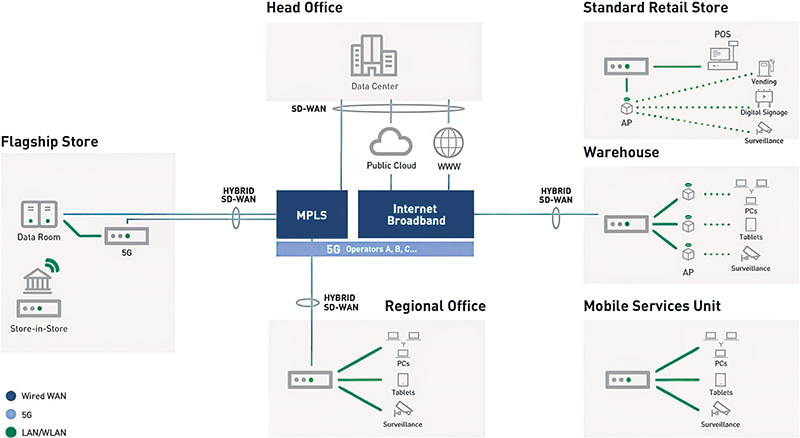Why Cellular 5G in SD-WAN Matters
By Safi Khan
March 6, 2025
Estimated reading time: 4 minutes
In the past, enterprises used private networks to give branches application and system access in their private data centers. With cellular 5G software-defined wide-area networks (SD-WANs), companies can ensure secure access to critical business systems. This allows their dispersed workforce to access corporate data with confidence.

Cellular 5G in SD-WAN empowers businesses to maintain control and security and seize the latest technology benefits, including:

SD-WAN has revolutionized how businesses connect with their distributed chain of physical locations. This technology combines multiple branch links with policy-driven WAN management and intelligent traffic directed across those links. SD-WAN enables enterprises to simplify and accelerate connectivity.
Businesses can take advantage of three fundamental SD-WAN capabilities:
Businesses can lower private WAN service costs and reduce outages, whether SD-WAN is deployed over:
Moreover, employees and partners in remote locations gain the collaborative, knowledge-rich environment they need to succeed.
Wireless networks evolved with 5G, ushering in a new era of ultrareliable, low latency and high performance. 5G can reach downlink speeds of multigigabits per second and uplink speeds of megabits per second. These speeds exceed data rates provided by traditional public wired internet options short of fiber.
These abilities made 5G the primary connection for distributed enterprises. 5G’s enhanced network reliability and availability also contributed to its adoption.
The Federal Communications Commission (FCC) spectrum auction improved cellular network capacity by auctioning wider bandwidth spectrum channels (e.g., C-band) for 5G use. Advancements in chipsets from companies like Qualcomm and data cards from Telit Cinterion have reduced costs and accelerated time to market. These easy-to-integrate solutions allow original equipment manufacturers (OEMs) to build optimized, low-cost products like routers and gateways.

Find an industrial-grade data card portfolio that supports mobile computing, networking and IoT application designs. Look for plug-and-play integration that covers performance and global certifications in the countries and mobile operators you want. See below how Telit Cinterion organizes its portfolio of data cards:
These products support the OnGo Alliance Citizens Broadband Radio System (CBRS) Band 48 (B48) and other private 4G and 5G bands. Many enterprises obtained licenses during the Priority Access License (PAL) auction. They plan to deploy private 5G in CBRS using broadband and SD-WAN devices. With private 5G and SD-WAN uniting to deliver new enterprise solutions, ensure your selected 5G portfolio covers it.
If your SD-WAN network requires positioning or precision real-time performance, these data cards support global navigation satellite systems, such as GPS, GLONASS, Galileo and BeiDou.
These Telit Cinterion data cards can help your business maximize 5G and LTE network use across regions and MNOs. For you, this means policy-based routing to application-specific traffic and real-time, high-quality data exchange across:
Eliminate latency and lost data with direct internet access and connectivity backed by a service-level agreement. Plus, you can enjoy seamless integration with cloud data centers and mobile devices. Speak with our SD-WAN experts to see how Telit Cinterion can help transform your corporate network.
Editor’s Note: This blog was originally published on 19 March 2018 and has since been updated.